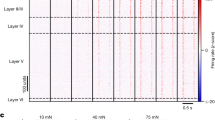Abstract
This chapter reviews our current understanding of the cellular and molecular basis of sensory transduction and neurotransmission in mammalian tactile afferents. Recent advances from in vitro studies and rodent models have provided important insights into the cell biology of tactile afferents. The chapter covers fundamental mechanisms of mechanotransduction in cells, how these mechanisms relate to C-tactile afferents, and mechanisms of neurotransmission in these neurons.
Access this chapter
Tax calculation will be finalised at checkout
Purchases are for personal use only
Similar content being viewed by others
References
Banks RW et al (2013) Glutamatergic modulation of synaptic-like vesicle recycling in mechanosensory lanceolate nerve terminals of mammalian hair follicles. J Physiol 591:2523–2540
Brumovsky PR (2013) VGLUTs in peripheral neurons and the spinal cord: time for a review. ISRN Neurol 2013:829753
Brumovsky P, Villar MJ, Hokfelt T (2006) Tyrosine hydroxylase is expressed in a subpopulation of small dorsal root ganglion neurons in the adult mouse. Expert Neurol 200:153–165
Chalfie M (2009) Neurosensory mechanotransduction. Nat Rev Mol Cell Biol 10:44–52
Coste B et al (2010) Piezo1 and Piezo2 are essential components of distinct mechanically activated cation channels. Science 330:55–60
Delfini MC et al (2013) TAFA4, a chemokine-like protein, modulates injury-induced mechanical and chemical pain hypersensitivity in mice. Cell Rep 5:378–388
Dong X, Han S, Zylka MJ, Simon MI, Anderson DJ (2001) A diverse family of GPCRs expressed in specific subsets of nociceptive sensory neurons. Cell 106:619–632
Faucherre A, Nargeot J, Mangoni ME, Jopling C (2013) piezo2b regulates vertebrate light touch response. J Neurosci 33:17089–17094
Fettiplace R, Kim KX (2014) The physiology of mechanoelectrical transduction channels in hearing. Physiol Rev 94:951–986
Fremeau RT Jr, Voglmaier S, Seal RP, Edwards RH (2004) VGLUTs define subsets of excitatory neurons and suggest novel roles for glutamate. Trend Neurosci 27:98–103
Harkany T et al (2004) Endocannabinoid-independent retrograde signaling at inhibitory synapses in layer 2/3 of neocortex: involvement of vesicular glutamate transporter 3. J Neurosci 24:4978–4988
Hu J, Chiang LY, Koch M, Lewin GR (2010) Evidence for a protein tether involved in somatic touch. EMBO 29:855–867
Ikeda R et al (2014) Merkel cells transduce and encode tactile stimuli to drive Abeta-afferent impulses. Cell 157:664–675
Kawashima Y, Kurima K, Pan B, Griffith AJ, Holt JR (2015) Transmembrane channel-like (TMC) genes are required for auditory and vestibular mechanosensation. Pflugers Arch 467(1):85–94
Kim SE, Coste B, Chadha A, Cook B, Patapoutian A (2012) The role of Drosophila Piezo in mechanical nociception. Nature 483:209–212
Kung C (2005) A possible unifying principle for mechanosensation. Nature 436:647–654
Kung C, Martinac B, Sukharev S (2010) Mechanosensitive channels in microbes. Annu Rev Microbiol 64:313–329
Kwan KY, Glazer JM, Corey DP, Rice FL, Stucky CL (2009) TRPA1 modulates mechanotransduction in cutaneous sensory neurons. J Neurosci 29:4808–4819
Lechner SG, Frenzel H, Wang R, Lewin GR (2009) Developmental waves of mechanosensitivity acquisition in sensory neuron subtypes during embryonic development. EMBO 28:1479–1491
Li L, Ginty DD (2014) The structure and organization of lanceolate mechanosensory complexes at mouse hair follicles. Elife 3:e01901
Li L et al (2011) The functional organization of cutaneous low-threshold mechanosensory neurons. Cell 147:1615–1627
Liu Q et al (2007) Molecular genetic visualization of a rare subset of unmyelinated sensory neurons that may detect gentle touch. Nat Neurosci 10:946–948
Lou S, Duan B, Vong L, Lowell BB, Ma Q (2013) Runx1 controls terminal morphology and mechanosensitivity of VGLUT3-expressing C-mechanoreceptors. J Neurosci 33:870–882
Lumpkin EA, Marshall KL, Nelson AM (2010) The cell biology of touch. J Cell Biol 191:237–248
Maksimovic S et al (2014) Epidermal Merkel cells are mechanosensory cells that tune mammalian touch receptors. Nature 509(7502):617–621
Mammoto T, Mammoto A, Ingber DE (2013) Mechanobiology and developmental control. Annu Rev Cell Mol Biol 29:27–61, 101512-122340
McKemy DD (2013) The molecular and cellular basis of cold sensation. ACS Chem Neurosci 4:238–247
Olausson H, Wessberg J, Morrison I, McGlone F, Vallbo A (2010) The neurophysiology of unmyelinated tactile afferents. Neurosci Biobehav Rev 34:185–191
Poole K, Herget R, Lapatsina L, Ngo HD, Lewin GR (2014) Tuning Piezo ion channels to detect molecular-scale movements relevant for fine touch. Nat Commun 5:3520
Quick K et al (2012) TRPC3 and TRPC6 are essential for normal mechanotransduction in subsets of sensory neurons and cochlear hair cells. Open biol 2:120068
Seal RP et al (2009) Injury-induced mechanical hypersensitivity requires C-low threshold mechanoreceptors. Nature 462:651–655
Vilceanu D, Stucky CL (2010) TRPA1 mediates mechanical currents in the plasma membrane of mouse sensory neurons. PloS one 5:e12177
Voglmaier SM et al (2006) Distinct endocytic pathways control the rate and extent of synaptic vesicle protein recycling. Neuron 51:71–84
Volkers L, Mechioukhi Y, Coste B (2014) Piezo channels: from structure to function. Pflugers Arch 467(1):95–99
Vrontou S, Wong AM, Rau KK, Koerber HR, Anderson DJ (2013) Genetic identification of C fibres that detect massage-like stroking of hairy skin in vivo. Nature 493:669–673
Weston MC, Nehring RB, Wojcik SM, Rosenmund C (2011) Interplay between VGLUT isoforms and endophilin A1 regulates neurotransmitter release and short-term plasticity. Neuron 69:1147–1159
Wetzel C et al (2007) A stomatin-domain protein essential for touch sensation in the mouse. Nature 445:206–209
Woo SH et al (2014) Piezo2 is required for Merkel-cell mechanotransduction. Nature 509:622–626
Zylka MJ, Dong X, Southwell AL, Anderson DJ (2003) Atypical expansion in mice of the sensory neuron-specific Mrg G protein-coupled receptor family. Proc Natl Acad Sci U S A 100:10043–10048
Acknowledgment
Research in the authors’ laboratories is supported by the National Institutes of Health (R01NS073119 and 5R21NS084191).
Author information
Authors and Affiliations
Corresponding author
Editor information
Editors and Affiliations
Rights and permissions
Copyright information
© 2016 Springer Science+Business Media New York
About this chapter
Cite this chapter
Seal, R.P., Lumpkin, E.A. (2016). Cell Biology of Tactile Afferents. In: Olausson, H., Wessberg, J., Morrison, I., McGlone, F. (eds) Affective Touch and the Neurophysiology of CT Afferents. Springer, New York, NY. https://doi.org/10.1007/978-1-4939-6418-5_3
Download citation
DOI: https://doi.org/10.1007/978-1-4939-6418-5_3
Published:
Publisher Name: Springer, New York, NY
Print ISBN: 978-1-4939-6416-1
Online ISBN: 978-1-4939-6418-5
eBook Packages: Biomedical and Life SciencesBiomedical and Life Sciences (R0)




